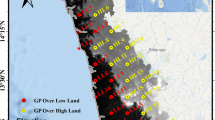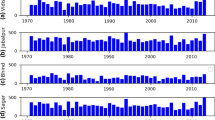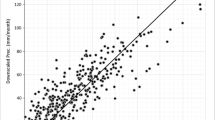Abstract
Global and regional scale climate teleconnection signals, including sea level pressure (SLP) and sea surface temperature (SST), are the main factors influencing the earth’s climate oscillations and are among the most important indices used to predict climatic variables. In this research, the effect of teleconnection signals on monthly maximum 1-day precipitation is examined using artificial neural network (ANN) and 40 years of rainfall data for the Madarsoo watershed located at the upstream of Golestan dam in Northern Iran. The Pearson correlation coefficient was used to determine the correlation between monthly maximum 1-day precipitation and climate signals with different lags. Different ANN models with various combinations of inputs, i.e., correlated SLP and SST with different lags, were then used for forecasting precipitation. Results revealed acceptable performance of ANN in forecasting monthly maximum 1-day precipitation using SST/SLP datasets. For instance, the performance indices including root mean square error (RMSE), correlation (R), and Nash-Sutcliffe (CNS) coefficients for monthly maximum 1-day precipitation of Tangrah rain gauge in August were found to be 6.12, 0.95, and 0.945 mm, respectively, for the test period.








Similar content being viewed by others
References
Acharya N, Kar SC, Mohanty UC, Kulkarni MA, Dash SK (2011) Performance of GCMs for seasonal prediction over India—a case study for 2009 monsoon. Theor Appl Climatol 105(3–4):505–520
Azimi M, Golpaygani F, Tajrishy MA (2011) Seasonal prediction of karoon streamflow using large-scale climate indices. In: World Environmental and Water Resources Congress, p 1184–1193
Coulibaly P, Anctil F, Bobée B (2000) Daily reservoir inflow forecasting using artificial neural networks with stopped training approach. J Hydrol 230(3–4):244–257
Dawson DW, Wilby R (1998) An artificial neural network approach to rainfall runoff modeling. Hydrol Sci J 43:47–66
Drosdowsky W, Chambers LE (2001) Near global scale sea surface temperature anomalies as predictors of Australian seasonal rainfall. J Clim 14:1677–1687
Enfield DB, Mestas-Nunez AM, Trimble PJ (2001) The Atlantic Multidecadal Oscillation and its relation to rainfall and river flows in the continental U.S. Geophys Res Lett 28(10):2077–2080
Fallah-Ghalhary GA (2011) The assessment of the role of climatic signal changes on spring rainfall oscillations, case study: Khorasan Razavi Province. J Earth Space Phys 3:155–171 (In Persian)
Fallah-Ghalhary GA (2012) Rainfall prediction using teleconnection patterns through the application of artificial neural networks. Mod Climatol 1:362–386
Fallah-Ghalhary GA, Habibi Nokhandan M, Mousavi Baygi M, Khoshhal J, Shaemi Barzoki A (2010) Spring rainfall prediction based on remote linkage controlling using adaptive neuro-fuzzy inference system (ANFIS). Theor Appl Climatol 101:217–233
Farokhnia A, Morid S, Byun H-R (2010) Application of global SST and SLP data for drought forecasting on Tehran plain using data mining and ANFIS techniques. Theor Appl Climatol 104(1–2):71–81. doi:10.1007/s00704-010-0317-4
Ghalkhani H, Golian S, Saghafian B, Farokhnia A, Shamseldin A (2013) Application of surrogate artificial intelligent models for real-time flood routing. Water Environ J 27(4):535–548
Ghayoor HA, Khosravi M (2001) Impact of NINO\Southern Oscillation (ENSO) on the summer and autumnal precipitation anomalies in South East of Iran. Geogr Res 62:141–174 (In Persian)
Hamilton JD (1994) Time series analysis. Princeton University Press, Princeton
Hsu K, Gupta HV, Sorooshian S (1995) Artificial neural network modeling of rainfall-runoff process. Water Resour Res 31(4):2517–2530
Kisi O, Cigizoglu HK (2007) Comparison of different ANN techniques in river flow prediction. Civil Eng Envrion Syst 24:211–231
Kumar DN, Reddy MJ, Maity R (2007) Regional rainfall forecasting using large scale climate teleconnections and artificial intelligence techniques. J Intell Syst 16(4):307–322
Meidani E, Araghinejad S (2014) Long-lead streamflow forecasting in the Southwest of Iran by sea surface temperature of the Mediterranean Sea. J Hydrol Eng 05014005. doi:10.1061/(ASCE)HE.1943-5584.0000965
Modarres R (2009) Multi-criteria validation of artificial neural network rainfall-runoff modeling. Hydrol Earth Syst Sci 13:411–421
Moetamedi M, Ehteramian K, Shahabfar AR (2007) The study of teleconnection between ENSO as a weather signals and rain fall and temperature fluctuations of the Khorasan Province. Environ Sci 4:75–90 (In Persian)
Moriasi DN, Arnold JG, Van Liew MW, Binger RL, Harmel RD, Veith T (2007) Model evaluation guidelines for systematic quantification of accuracy in watershed simulations. Trans ASABE 50(3):885–900
Munoz-Diaz FS, Rodrigo FS (2006) Effects of the North Atlantic Oscillation on the probability for climatic categories of local monthly rainfall in Southern Spain. Int J Climatol 23:381–397
Nazemosadat MJ, Cordey I, Eslamian S (1995) The impact of the Persian Gulf Sea surface temperature on Iranian rainfall. In: Proceedings of the Iranian Water Resource Management Conference, Esfahan, Iran, p 809–819
Nazemosadat MJ, Samani N, Barry DA, Molaii Niko M (2006) ENSO forcing on climate change in Iran: precipitation analysis. Iran J Sci Technol Trans B Eng 30:555–565
Nicholls N (1989) Sea surface temperatures and Australian winter rainfall. J Clim 2(9):965–973
Okkan U (2011) Application of Levenberg-Marquardt optimization algorithm based multilayer neural networks for hydrological time series modeling. Int J Optim Control Theor Appl (IJOCTA) 1(1):53–63
Philip J (2003) A neural network tool for analyzing trends in rainfall. Comput Geosci 29(2):215–223
Rezaebanafsheh M, Jahanbakhsh S, Bayati M, Zeynali B (2011) Forecasting autumn and winter precipitation of west of Iran applying Mediterranean SSTs in summer and autumn. Phys Geogr Res Q 74(4):47–62
Soukup TL, Aziz OA, Tootle GA, Piechota TC, Wulff SS (2009) Long lead-time streamflow forecasting of the North Platte River incorporating ocean-atmospheric climate variability. J Hydrol 368(1–4):131–142
Tabari H, Abghari H, Hosseinzadeh Talaee P (2013) Impact of the North Atlantic Oscillation on streamflow in Western Iran. Hydrol Process. doi:10.1002/hyp.9960
Valverde Ramírez MC, de Campos Velho HF, Ferreira NJ (2005) Artificial neural network technique for rainfall forecasting applied to the São Paulo region. J Hydrol 301(1–4):146–162
Wei S, Yang H, Song J, Abbaspour K, Xu Z (2013) A wavelet-neural network hybrid modelling approach for estimating and predicting river monthly flows. Hydrol Sci J 58(2):374–389
Wu C (2010) Hydrological predictions using data-driven models coupled with data preprocessing techniques, Ph.D thesis, The Hong Kong Polytechnic University, Pao Yue-Kong Library, January 2010
Wu A, Hsieh WW, Shabbar A (2005) The nonlinear patterns of North American winter temperature and precipitation associated with ENSO. J Climate 18:1736–1752. doi:10.1175/JCLI3372.1
Wu A, Hsieh WW, Tang B (2006) Neural network forecasts of the tropical Pacific sea surface temperatures. Neural Netw Off J Int Neural Netw Soc 19(2):145–154
Yarahmadi D, Azizi GH (2007) Analytical relationship between seasonal rainfall in Iran and climate index. Geogr Res 62:161–174 (In Persian)
Author information
Authors and Affiliations
Corresponding author
Rights and permissions
About this article
Cite this article
Ruigar, H., Golian, S. Prediction of precipitation in Golestan dam watershed using climate signals. Theor Appl Climatol 123, 671–682 (2016). https://doi.org/10.1007/s00704-015-1377-2
Received:
Accepted:
Published:
Issue Date:
DOI: https://doi.org/10.1007/s00704-015-1377-2




